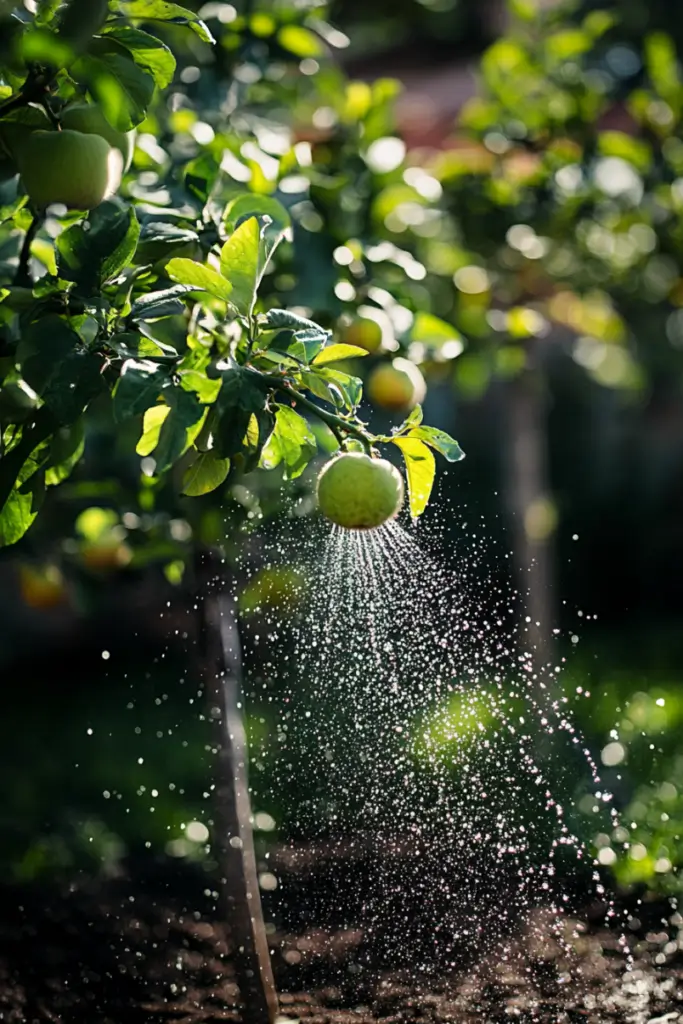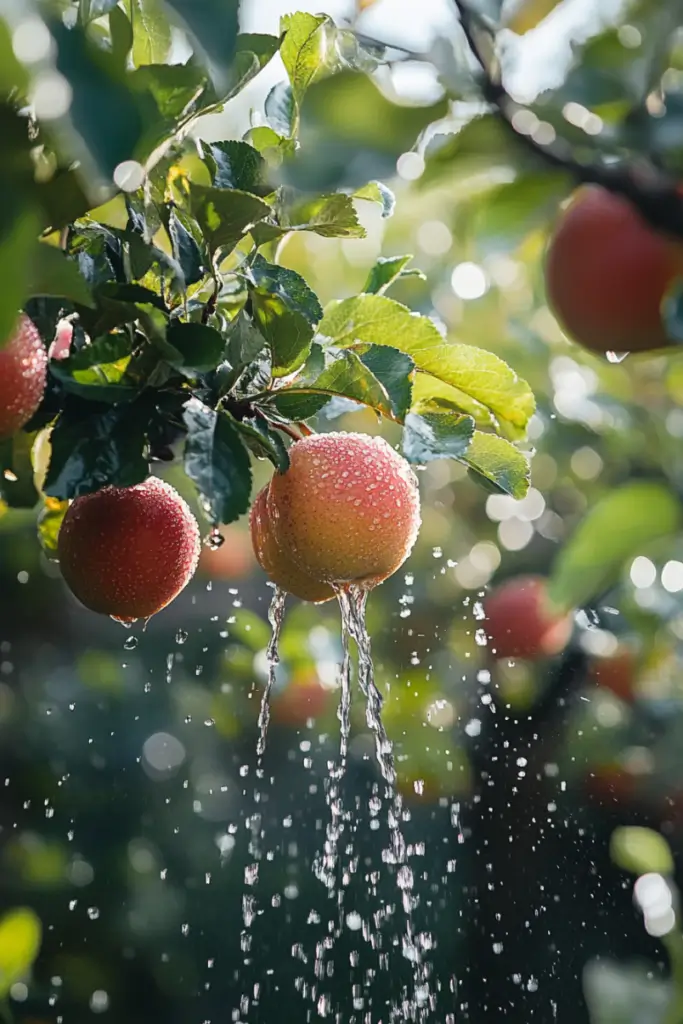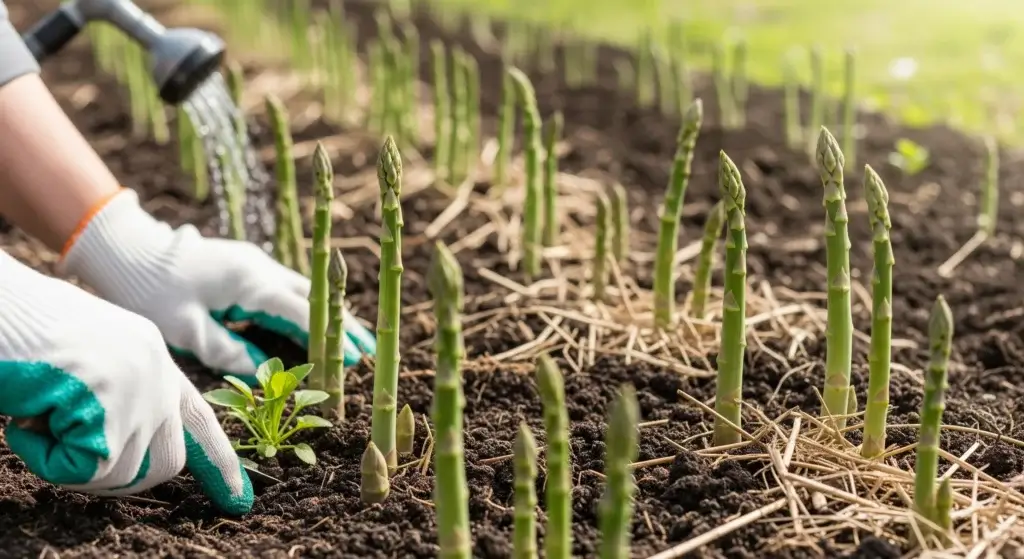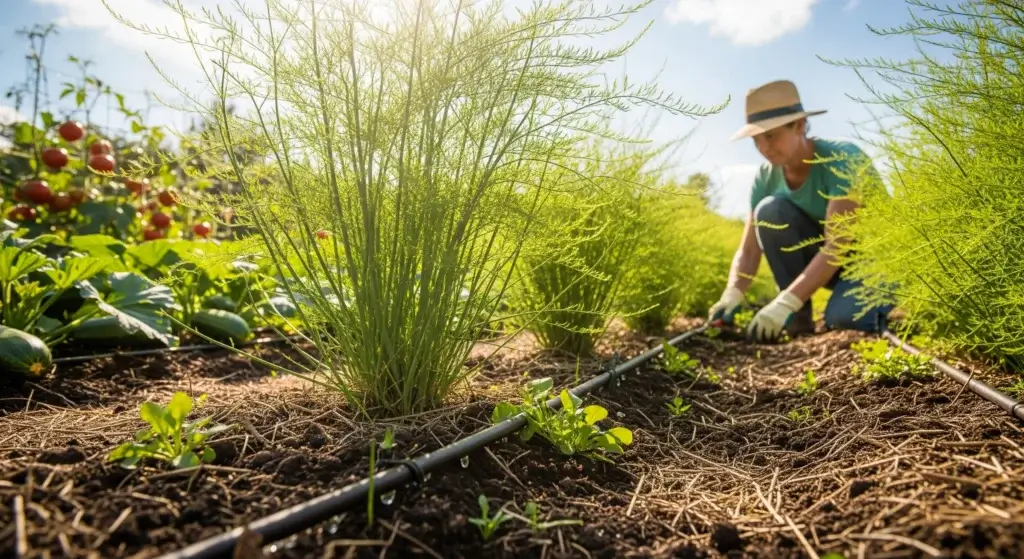
Watering fruit trees is essential for keeping them healthy and productive.
Proper watering helps trees absorb nutrients, develop strong roots, and produce abundant fruit.
But it’s not as simple as just turning on the hose—different fruit trees, soil types, and climates each have specific watering needs.
Too little water can stress trees, leading to poor fruit production and even tree death.
On the other hand, overwatering can suffocate the roots, causing rot and attracting pests.
The key is to find the right balance to ensure your fruit trees thrive and have a successful growing season.
Benefits of Well-Watered Fruit Trees
When fruit trees receive the right amount of water, they enjoy several benefits:
Stronger root systems
Proper watering encourages roots to grow deeper.
Deep roots help trees survive droughts and withstand severe weather conditions better.
Trees with strong root systems are more stable and resilient.
- Read also: Banana Plant Watering: A Guide for Healthy Growth
- Read also: DIY Plant Watering System: Keep Your Plants Hydrated
Better Fruit Production
Consistent moisture leads to more and higher-quality fruit.
Studies have shown that even a small amount of water stress can reduce fruit size and yield by 15-30%.
Keeping your trees well-watered ensures they produce abundant and healthy fruit.
Increased resilience to disease
Trees that are well-hydrated are better at resisting pests and diseases.
This means you’ll likely need fewer chemical treatments, which is better for both the tree and the environment.
Improved nutrient uptake
Water helps dissolve nutrients in the soil, making it easier for roots to absorb essential minerals like nitrogen, potassium, and phosphorus.
This leads to healthier trees and better fruit production.

Common Watering Mistakes
Even experienced gardeners can make errors when watering fruit trees. Here are some common mistakes to avoid:
Shallow watering
Watering just the surface of the soil can lead to shallow roots.
Shallow roots make trees more susceptible to drought and can make them unstable in strong winds.
It’s important to water deeply to encourage roots to grow down into the soil.
Overwatering
Providing too much water can suffocate the roots and create conditions for root rot.
Root rot weakens the tree and reduces its fruit production.
Ensure you water just enough to keep the soil consistently moist, but not waterlogged.
Inconsistent watering
Fruit trees need regular moisture, especially during the growing and fruiting seasons.
Skipping water during hot periods can lead to fruit drop or poor-quality fruit.
Aim to water consistently to keep trees healthy.
Watering the trunk
Watering directly at the trunk is not effective.
Instead, water around the drip line of the tree, which is where the feeder roots are located.
This ensures that the water reaches the roots where it’s needed most.
Factors Affecting Water Needs
Several factors can impact how much water your fruit trees require.
Here’s what to consider ensuring your trees get just the right amount:
Tree age
Young trees need more frequent watering to help them develop strong roots.
As trees mature, they need less frequent watering, but the watering should be deeper to reach the established root system.
Tree type
Different types of fruit trees have varying water needs.
For example, citrus trees generally require more water than apple or peach trees.
Stone fruit trees, like cherries or plums, need extra water during their fruiting season to support fruit development.
Soil type
The type of soil around your trees affects how often you need to water.
Sandy soils drain quickly and dry out faster, so they need more frequent watering.
Clay soils, on the other hand, hold water longer, so they require less frequent irrigation.
Climate
The climate where you live also plays a big role.
In hot, dry climates, your trees will need more water, especially during the summer.
In cooler or wetter climates, you’ll generally need to water less often.

Signs of Under- and Over-Watering
Keeping an eye on your trees helps you understand whether they’re getting the right amount of water.
Here’s what to look for:
Signs of under-watering
- Wilting leaves: If your tree’s leaves are curling, wilting, or turning yellow, it might not be getting enough water.
- Dry, cracked soil: Soil that feels hard and dry a few inches below the surface is a sign your tree isn’t receiving enough moisture.
- Smaller fruit: Trees under stress from lack of water often produce smaller and less developed fruit.
Signs of overwatering
- Yellowing leaves: Leaves turning yellow without wilting can indicate that the tree is getting too much water.
- Soggy soil: Soil that remains constantly wet suggests that the tree’s roots may be waterlogged.
- Root rot: This fungal disease occurs when roots stay damp for too long. It can weaken and even kill the tree.
Watering Techniques
Choosing the right watering method can make a big difference in the health of your fruit trees.
Here are some effective techniques to consider:
Deep watering
Deep watering means applying water slowly and deeply, so it reaches the deeper parts of the soil where the roots are located.
This encourages roots to grow downward, making them more drought resistant.
You can use tools like a soaker hose or a slow-drip system for this method.
Aim to water so that moisture reaches 12-24 inches into the soil, which is where most of the fruit tree roots are found.
Typically, deep watering once a week is sufficient for mature trees.
This technique helps ensure that your trees have a strong, healthy root system.
Drip irrigation
Drip irrigation is a very effective method for watering fruit trees.
It involves using a system that delivers water directly to the roots.
This approach minimizes water waste by reducing evaporation and runoff.
The water drips slowly and steadily, allowing it to soak deeply into the soil without making it too wet.
Drip irrigation systems can often be set on a timer, making them a convenient option for busy gardeners or those with many trees.
Hand watering
For smaller fruit trees or if you only have a few trees, hand watering with a hose is a straightforward method.
When hand watering, make sure to do it slowly so the water penetrates the soil rather than just sitting on the surface.
It’s best to water around the base of the tree where the roots are and avoid getting water on the leaves to prevent fungal diseases.

Watering Schedule
Creating an effective watering schedule for your fruit trees involves understanding their age, needs, and the local climate.
Here’s a simple guide to help you:
Newly planted trees
For trees that you’ve just planted, it’s crucial to give them extra attention to help them establish strong roots.
During the first year, water them twice a week.
This frequent watering helps the roots spread out and settle into the soil.
Young trees (1-3 years old)
As your trees grow, they’ll need less frequent watering but still require regular moisture.
For trees in this age range, water once a week.
Aim to keep the soil moist to a depth of 12-24 inches, which is where most of the roots are.
This helps the tree build a robust root system without overwatering.
Mature trees
For trees that are fully established, a watering schedule of every two weeks during the growing season is generally sufficient.
However, during fruiting periods or particularly hot weather, increase the frequency to keep the trees healthy and productive.
Special considerations
In extremely hot or dry climates, you may need to water more frequently than the guidelines suggest.
Always monitor the condition of your soil and the health of your trees.
If the soil feels dry or the trees show signs of stress, adjust your watering schedule accordingly.

- Read also: Nurturing Greenery: A DIY Potted Plant Watering System Guide
- Read also: DIY Ideas: Perfect Outdoor Potted Plant Watering System
Final Thoughts
Watering fruit trees may seem like a simple task, but it requires careful attention to detail.
From understanding the tree’s water needs based on its age and type to employing effective watering techniques like deep watering or drip irrigation, proper watering is essential for a fruitful harvest.
Avoid common mistakes like shallow or inconsistent watering and watch for signs of under- or over-watering to keep your trees healthy and productive.
FAQs
The frequency depends on the tree’s age, type, and climate. Generally, young trees need watering once a week, while mature trees need it every two weeks.
Early morning is ideal because it reduces water loss due to evaporation and gives the tree time to absorb moisture before the heat of the day.
Yes, overwatering can lead to root rot and other fungal diseases. Always check the soil moisture before watering again.
Yes, fruiting trees typically need more water to support fruit development, especially during hot weather.
Deep watering or drip irrigation is recommended because it ensures water reaches the root zone without wasting water through evaporation or runoff.



